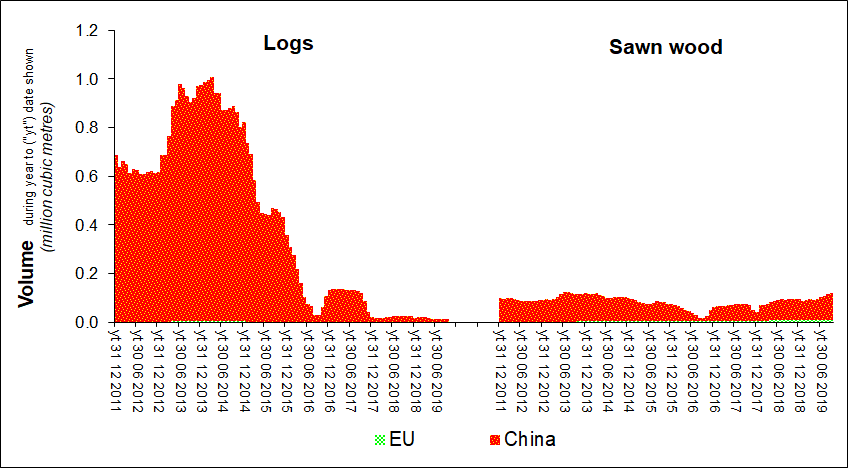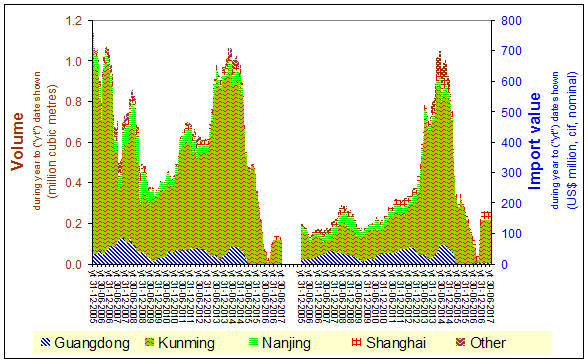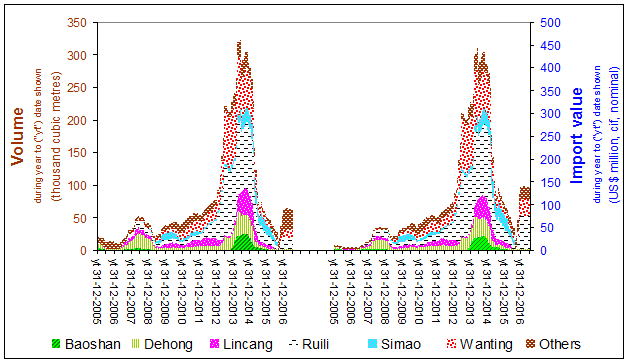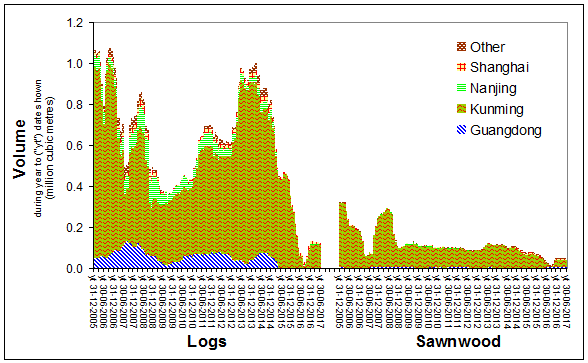|
|
||||||||||||||||||||||||||||||||||||||||||||||||||||||||||||||||||||||||||||||||||||||||||||||||||||||||||
|
Myanmar
(previously Burma)
|
||||||||||||||||||||||||||||||||||||||||||||||||||||||||||||||||||||||||||||||||||||||||||||||||||||||||||
|
China
and the EU's imports of logs and sawnwood from Myanmar
Sources: based on Eurostat and General Administration of Customs of the People's Republic of China Click here for a detailed summary of EU Member States' imports of wood-based products from Myanmar  |
||||||||||||||||||||||||||||||||||||||||||||||||||||||||||||||||||||||||||||||||||||||||||||||||||||||||||
|
CChina's
imports of logs from Myanmar - by "customs district" China's
imports of "rosewood" logs from Myanmar - by "location
of importer" China's
imports of logs and sawn wood from Myanmar - by "customs district" |
||||||||||||||||||||||||||||||||||||||||||||||||||||||||||||||||||||||||||||||||||||||||||||||||||||||||||
|
Myanmar During 2017, the government of Myanmar might lift the ban on logging in (and clearance of) natural forest which it imposed during 2016. That ban followed renewed efforts to enforce the prohibition of exportng logs which it introduced in April 2014. Those efforts were effective for a couple of months, until October 2016, when China, implicitly ignoring the sovereign will of its neighbour, recommenced imports of logs via Yunnan. This has become common practice whenever Myanmar has banned the overland export of logs. The recent surge largely comprised rosewood and teak. Those rosewood imports might have been prompted partly by traders' desire to profit prior to 01 01 2017 when China would be obliged to implement Appendix II CITES controls - thereby tending to confirm those logs' illegality and unsustainable derivation. During 2011, it became apparent that the government of Myanmar (Burma) planned to substantially reduce the volume of logs which are officially exported from Burma. [p6] The goverment subsequently announced that it would prohibit official exports of logs with effect from 01 April 2014.[p6][p5] As the charts above indicate, the great majority of the logs (and almost all the sawn wood) which China imports from Burma are supplied overland. Consequently, timing differences can not account for why the volume of logs which China imported overland from Burma during April was almost as great as it had been for many years. It is unclear whether powerful interests (in local, provincial or national government) are complicit in this continued importation of what has for many years been known to be illegal (if not also "conflict") timber. However, it may be that China feels unable to close its border to supplies of logs from Burma until the government of Burma - at the highest levels - formally and publically- requests that their counterpart(s) in China prohibit the entry of all logs supplied overland from Burma untilsuch time as Burma relaxes its ban on official exports of logs. However, during December 2013, Burma formally requested that China stops illegal logs being transported across the border with Burma.[p6] It is unclear whether this is a prelude to Burma seeking compensation from (/suing) China (specifically the government of Yunnan) for being complicit in the environmental damage which that "trade" causes - the Burmese people and their environment in effect and unwittingly subsidising / enabling China's profit. Since early 2013, there has been a surge in China's imports of rosewood logs from Burma via Yunnan - implicitly overland. The source of those logs is unclear. However, it might reflect the smuggling of rosewood logs from neighbouring countries in response to the recent CITES Appendix II listing of Dalbergia cochinchinensis. It might reflect traders' efforts to maximise supplies prior to the anticipated prohibition an the export of logs (likely to enter force from April 2014) - but it is perhaps too soon to be starting to stock pile logs. It might well be attributable to a ceasefire in the conflict which divides Burma, and if so that rosewood might derive from land controlled by the new government of Burma. It is likely to be illegal, particularly if it derives from elsewhere in Burma (or neighbouring countries), unless it is accompanied by genuine documentation from the government of Burma authorising its export. Indeed, a report (published in 2014) [-] suggests that the great majority of the timber which enters Yunnan from Burma is illegal. Most of the increase is likely to pass through either Ruili or Wanting. There has also been a slight increase in the quantity of logs other than rosewood which China imports from Burma.
China's
imports of "rosewood" logs from Myanmar (source:
as above)
China's
imports of logs other than "rosewood"
from Myanmar (source:
as above)
Suggested
reading:
|
||||||||||||||||||||||||||||||||||||||||||||||||||||||||||||||||||||||||||||||||||||||||||||||||||||||||||
|
Copyright
globaltimber.org.uk
|
||||||||||||||||||||||||||||||||||||||||||||||||||||||||||||||||||||||||||||||||||||||||||||||||||||||||||



